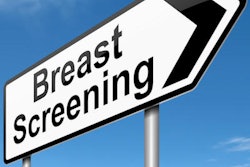
Risk-based mammography screening has been touted as a way to minimize the modality's harms and boost its benefits. But does risk-based screening really save more lives, especially when it comes to younger women? It may not, according to a new study published online June 11 in Radiology.
Although risk-based breast cancer screening seems like a good idea to tailor mammography to a woman's risk profile, younger women often don't present with many risk factors. But when they do develop cancer, catching and treating it early is crucial, wrote a team led by Dr. Elizabeth Burnside of the University of Wisconsin-Madison.
"Risk-based screening in women 40 to 49 years old aims to balance the benefits with harms," the group wrote. "However, risk-based protocols may eliminate the mortality benefits of screening."
Most population-based mammography screening trials have used an age-based rather than a risk-based model, in deference to the need to test risk-based screening before putting it into place, Burnside and colleagues wrote. But in an era of ever more focus on curbing healthcare overspending, interest in risk-based screening has increased.
"Growing interest in risk-based screening creates an urgent mandate to determine [its] effectiveness," they noted.
For the study, the researchers compared the trade-offs of risk- versus age-based breast cancer screening protocols in a population of 71,148 mammograms in 24,928 women screened between January 2006 and December 2013.
The researchers considered two hypothetical scenarios: age-based (age 45 and older) and risk-based (five-year risk of breast cancer greater than that of an average 50-year-old woman). Risk factors included family history, race, age, prior breast biopsy, and breast density; Burnside and colleagues assessed outcomes for cancer detection, false positives, and benign biopsy findings.
The study included women ages 40 to 49 years, with 50 screening-detected cancers, 1,787 false-positive mammograms, and 384 benign biopsy results. The age-based screening strategy revealed more cancers than did the risk-based one, although it did prompt more false positives and benign biopsy results.
| Age- vs. risk-based breast cancer screening protocols in women ages 40 to 49 | ||
| Performance measure | Age-based screening protocol | Risk-based screening protocol |
| Cancers detected (50) | 34 | 13 |
| False positives (1,787) | 899 | 216 |
| Benign biopsy results (384) | 175 | 49 |
It's true that what some call the "harms" of mammography increased with the age-based screening protocol, but so did the cancer detection rate, which almost tripled.
"If a woman has a mammographically detectable cancer but is not eligible for screening, the impact of undetected cancers depends on the length of the diagnostic delay and tumor behavior, which tends to be more aggressive in younger women," the group wrote. "A substantial delay would increase the likelihood that a cancer would be detected clinically, be larger, and be node positive."
A risk-based screening protocol exposes women to delays in diagnosis, which could significantly affect the breast cancer mortality rate in younger women -- and could prompt an increase in the very healthcare costs risk-based screening is trying to avoid, according to the authors.
"When choosing a screening strategy, physicians, patients, and policymakers will need to determine whether the trade-offs in both short-term and long-term outcomes are acceptable, while also weighing the practicality and complexity of each strategy," they concluded.




















